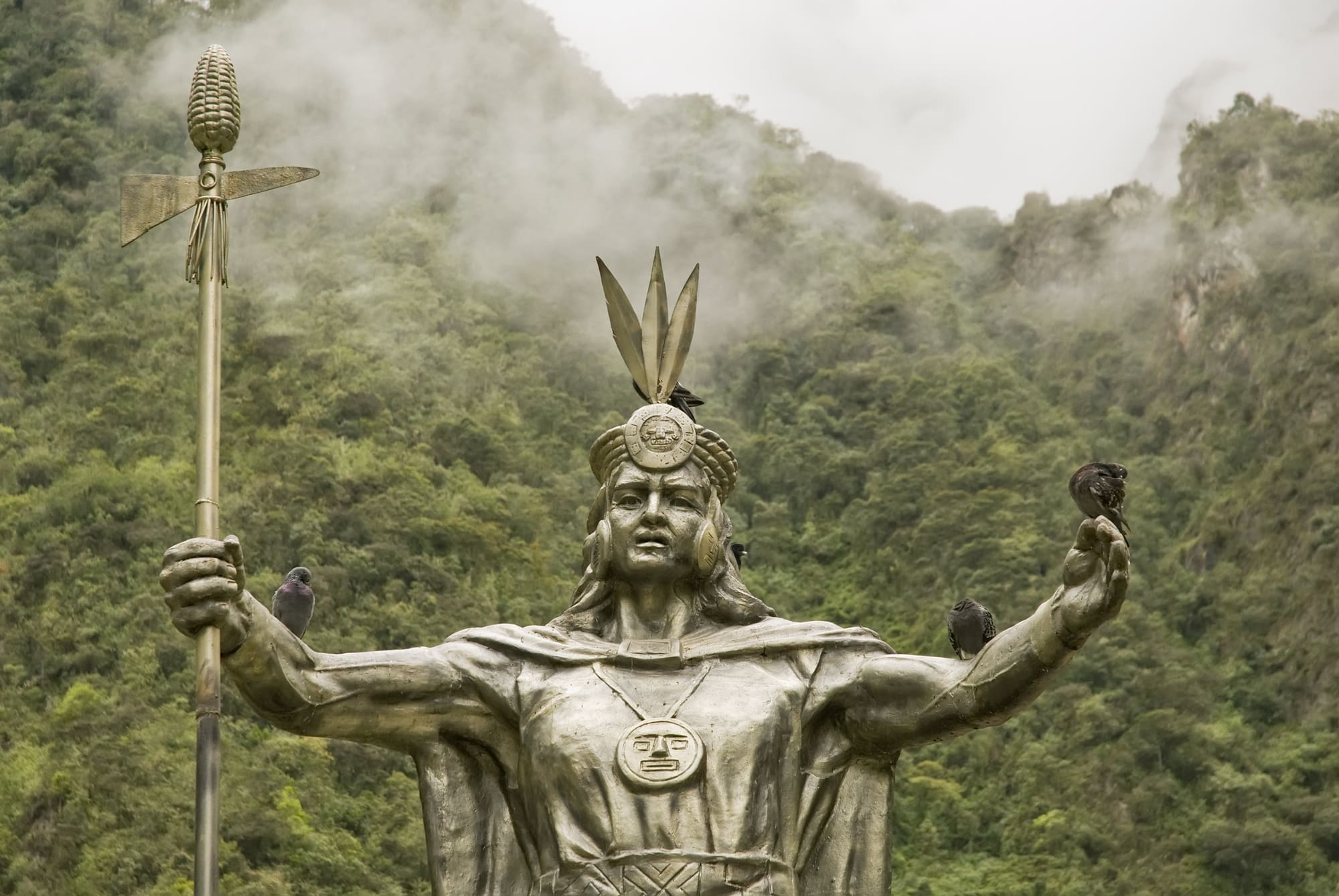The Inca were one of the Indigenous Peoples of the Americas who established the Inca Empire. By 1400 AD, they were a small tribe. But by the time Christopher Columbus landed in the Caribbean a hundred years later, they had established a mighty empire in South America. Their empire stretched across parts of Peru, Bolivia, Ecuador, and Chile. It was the largest empire on earth at that time, with almost 10 million people living under its banner.
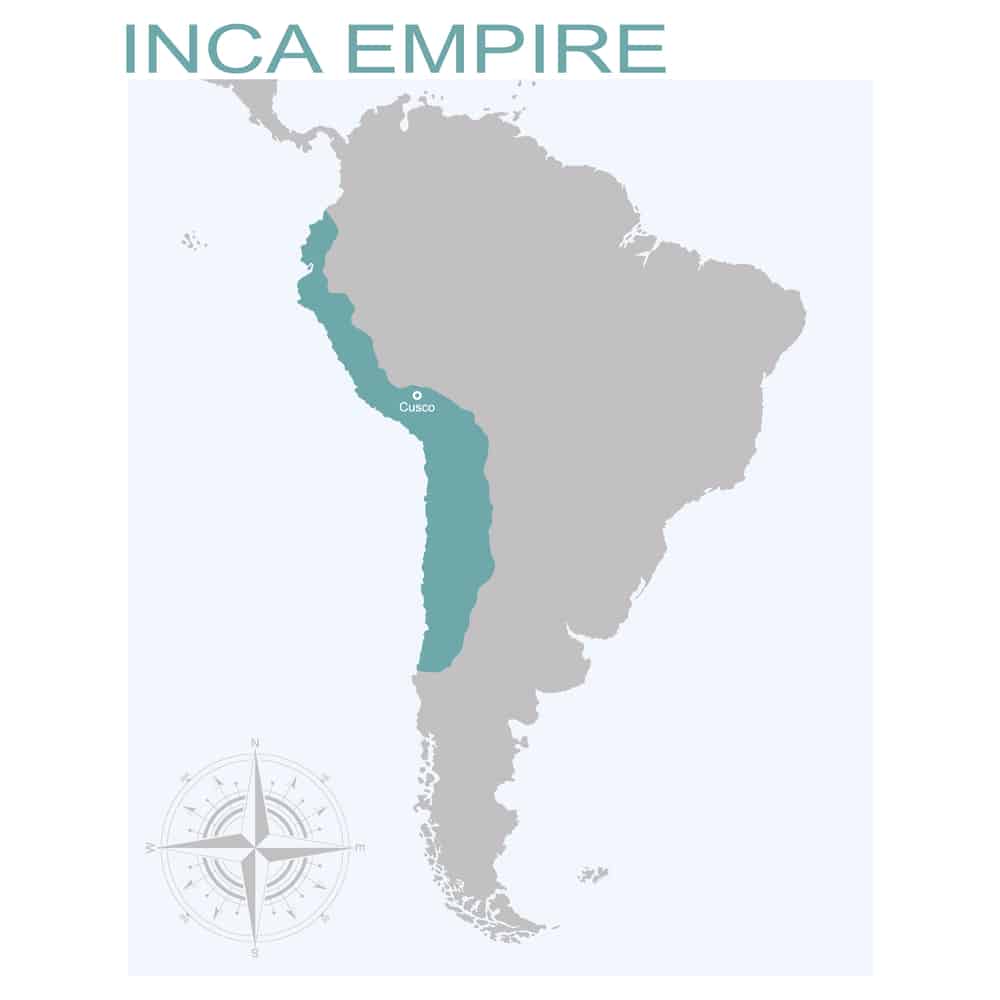
But how did such a small tribe rise to prominence so fast? How could they defeat the other kingdoms in that area so easily? Read this blog post to find out.
Origin
The ancestors of the Inca were the People from Siberia who first migrated to Beringia 24,000 years ago. These people stayed in Beringia for thousands of years and then moved to different parts of the American continent.
Some of these people reached South America too. There, they learned to cultivate crops like corn, potato, and cotton. Then, between 3000 BC and 2500 BC, they started to domesticate animals like llamas and alpacas. These animals served as a good source of meat and wool and could carry almost one-fourth of their weight. So, they proved highly beneficial for food, clothing, and carrying goods.
Thus, keeping farming and animal husbandry at their core, several complex societies originated in this area. These complex societies eventually gave rise to different cultures, which are collectively called the Andean civilizations.
The Inca were one of such different cultures that began as a small tribe. In the 12th century, searching for land to farm, they came to Cusco, a city in present-day Peru. Since the soil there was fertile, they settled there.
But even though the Inca came to Cusco in the 12th century, nobody knows where they were before that. We only have the Inca origin myths to rely on, which were passed through generations of the Inca orally.
Inca Origin myths
The Inca have four mythical tales that explain their origin. The most prominent among them is the story of Manco Capac and his magic staff.
According to this myth, the Inca were created by their sun god Inti. After creating them, Inti sent his four sons and four daughters to earth. They came to earth through a cave. This cave was located in the center of the line along which two other caves were located. From the other two caves, people carrying seeds came out. These people would eventually become the ancestors of the Inca today.
These four brothers and four sisters were supposed to lead the Inca and show them where to settle.
One of these brothers had magical powers and was too strong. So, afraid of him, the other brothers tricked him into entering a cave and closed its entrance. After this incident, one of the other brothers climbed the cave and proclaimed that he would look after the Inca. Once he proclaimed that, he turned to stone. Looking at all this fuss, one of the two remaining brothers left the Inca and started his own journey. So, finally, only one brother, Ayar Manco, was left. He eventually married his older sister, who bore him a son.
Ayar Manco carried a magic staff made of gold. This magic staff would show the Inca where to settle. So, the Inca started traveling, searching for a place where this staff would sink into the ground.
Cusco
When they reached the valley near Cusco, Ayar Manco’s staff sank into the ground. So, taking it as the divine sign they were waiting for, the Inca decided to settle there. But there were people already living there. Therefore, the Inca fought against these people, chased them out of their land, and settled in Cusco around 1200 A.D.
After this victory, Ayar Manco came to be known as Manco Cápac, the one who founded the Inca.
This is one of the four myths that explain where the Inca came from. The Inca didn’t have a writing system. These myths were only passed down through generations of the Inca orally. So, nobody knows which of these myths to believe in.
The Inca Empire
But regardless of which myth was true, the Inca settled in Cusco around 1200 AD.
Initially, the Inca were a pastoral tribe. They were shepherds who tended to Llamas and Alpacas. They roamed far and wide, looking for a place for these animals to graze.
But the place where the Inca settled, Cusco, was located between two empires that existed earlier. These empires had already built the infrastructure needed to expand and maintain the areas under their control. So, when the Inca started expanding, they didn’t have to build everything from scratch. The roads, the hydraulic systems, and other systems the Inca needed to establish an empire were already partly in existence.
So, utilizing this already available infrastructure, the Inca started to expand.
Viracocha
The Inca’s expansion began during the rule of their fourth emperor Mayta Capac. This expansion continued over several generations, and by the time their eighth emperor Viracocha Inca came to power, they had become a truly expansive tribe. Viracocha is the Inca ruler who introduced the custom of leaving some of his soldiers behind in conquered lands. This practice helped the Inca make sure that the conquered lands were loyal to them.
Pachacuti Inca Yupanqui
In 1438, when Chancas, enemies of Inca, attacked Cusco, Viracocha escaped to a military outpost. His son Urco, who was to become the next Inca king, also fled the capital with his father.
But for Viracocha Inca’s third son, Cusi Inca Yupanqui, who had no claim to the throne, it was a brilliant opportunity to display his talent. So, he refused to abandon the capital. Instead, he and his other brothers rallied the armies and launched a desperate defense.
The Inca revered Yupanqui greatly for not running away even when fighting was futile. So, they stood up against the invaders and fought alongside Yupanqui very bravely. Yupanqui was able to inspire the Inca so much that it was said that even the stones in Cusco rose up to fight on his side. As a result, the Inca defeated the Chancas decisively and captured many of their leaders.
After winning the war and the hearts of his people, Inca Yupanqui demanded to be made the next emperor. But his father Viracocha refused and tried to assassinate him instead. When the assassination attempt failed, Viracocha fled the country.
Inca Yupanqui became the next Inca emperor and renamed himself Pachacuti, which meant the ‘Earth Shaker.’ Pachacuti would eventually become one of the most influential Inca rulers, transforming the Cusco kingdom into Tawantinsuyu, the far-reaching Inca Empire.
Expansion of the Inca Empire
Pachacuti expanded the borders of his empire through both conquest and friendship. He used a simple process for this purpose.
First, he sent spies to the kingdom he wished to conquer. Once his spies returned with information about the kingdom, he sent luxurious gifts to its ruler, stating the advantages of joining the Inca Empire. If the ruler accepted the gifts, his kingdom was peacefully annexed into the Inca Empire. The rulers of most kingdoms accepted Pachacuti’s proposal.
But If the ruler refused to accept his proposal, Pachacuti sent a threat of war.
If the ruler still did not give up, Pachacuti defeated the kingdom through military conquest. He then executed its leaders and brought their sons to Cusco to teach them about the Inca culture. Once they have grown up and learned about the Inca culture, they were sent back to rule their kingdoms. Thus, Pachacuti converted his enemies into Inca nobility, and at times, even married off Inca women to them to ensure their loyalty.
But as Tawantinsuyu grew larger, the chances that a conquered tribe would rebel increased. So, in such cases, when Pachacuti sensed that a conquered ethnic group would rebel, he allegedly displaced thousands of its people and redistributed them into the farthest regions in his empire so that they could have no chance of organizing a rebellion.
Thus, Pachacuti and his successors expanded the borders of the Cusco kingdom and transformed it into the mighty Inca Empire. But conquering the regions was only one aspect of a great empire. The more important aspect was to incorporate the conquered lands into the empire.
Pachacuti knew that very well. So, he reorganized the government by transforming the Cusco kingdom into Tawantinsuyu.
The Inca government
In the system of Tawantinsuyu, the Sapa Inca, the sole ruler, was at the core. He had absolute power in the Empire. He lived in the Inca capital Cusco, which was practically an impenetrable stronghold because of the fortresses Pachacuti had built there to withstand enemy attacks.
Surrounding the capital on four sides were the four Suyus, the four regions of the Inca Empire.
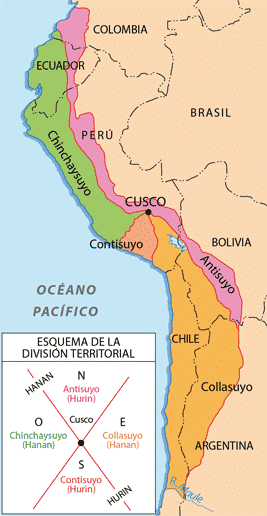
Cusco and the four Suyus (Picture Credits)
Each Suyu was further divided into provinces called Wamani. Most of these provinces were actually tribes that had previously been conquered by the Inca. Each of these provinces, in turn, was subdivided into several factions. The smallest entity of the Tawantinsuyu was the Ayllu.
Each Ayllu functioned as an individual unit. Therefore, even though each Ayllu consisted of several families, in reality, an Ayllu was just like a big family.
The government allocated land to each Ayllu based on the number of people in that Ayllu. In return, each Ayllu had to pay tax to the government.
Inca taxation system
There were two types of taxes that the Ayllu paid to the government. The Inca didn’t have a currency. So, they didn’t pay money to the government. Instead, they paid taxes in other ways.
The first tax they paid to the government was a portion of their crops. The crops they gave as the tax was then divided into three parts. The first part went to the government, the second part went to the priests, and the final part went to the people.
The second tax they paid to the government was in the form of labor. They paid this tax by working for the government. They built roads, constructed buildings, mined gold, and even worked as warriors for the army.
In return for their labor, the Inca people were provided feasts on special occasions by their ruling authority. After all, the Inca didn’t use any form of money. And they didn’t need it either, because there were no markets or shops in the Inca Empire. So, there was nothing they could buy. All their requirements, like food, clothes, and tools were provided by the government. Therefore, the feasts served as the payment for their labor.
Thus, by establishing such a well-defined hierarchical government, the Inca emperor was able to rule such a vast empire.
The Inca social structure
The vast empire of the Inca was formed by conquering various tribes. So, even though it was just one empire in name, more than a hundred ethnic groups lived under its banner. Hence, to bring all of its 12 million inhabitants with varied ethnic origins into one system, the Inca followed a strict social structure.
This hierarchical social system assigned each person in the empire to one of the four classes:
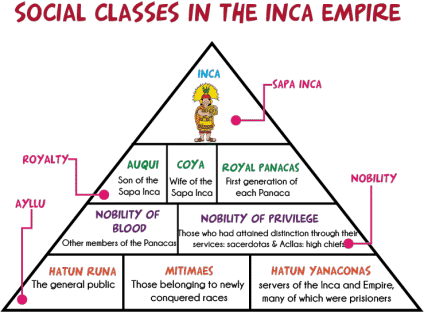
The Inca social class structure (Picture Credits)
The King
At the top of the hierarchy was the Inca emperor. The Inca believed that their king was the son of their sun god. So, he was the wealthiest, most powerful, and most respected person in the entire kingdom. He had several wives and children. The Inca called him Sapa Inca.
The Royalty
Below the king was the Royalty. The king’s family and his relatives formed this class of the Inca. They enjoyed all the luxuries in the kingdom and were the most respected people after the king.
The Nobility
The next class in the Inca social system was Nobility. Nobility could be achieved either by blood relations or by showing distinction in one’s service to the empire. This category included high priests, the army commander, army generals, other special military members, architects, artisans, and local leaders. These people enjoyed several privileges.
For example, the local leaders were considered important, and hence, commoners brought gifts to them often. The king considered them essential as well. Therefore, he exempted them from paying taxes. Thus, local leaders enjoyed several privileges both from the king for whom they worked as well as the commoners whom they governed.
The Commoners
Most of the population of the Inca fell under the remaining social class – the Commoners. This was the lowest class in the social hierarchy of the Inca. As the lowest social class, the commoners received only low wages even when they did all the hard manual work in the empire. Farmers, shepherds, servants for nobles or royal families, and slaves were considered commoners.
How did the Inca Empire grow so rapidly?
Besides their efficient government, strict social structure, and intimidating military, there were also other factors that contributed to the Inca’s rapid growth.
1. Extensive roadways
The Inca had an extensive network of roads, whose length added up to 15,000 miles. But strangely, commoners were not permitted to use Inca roads. Only the King, Royal people, and Nobles were allowto use the roads. The other category of people who were permitted to use these roads were Relay runners. They were messengers who covered almost 150 miles/day, to relay information from one corner of the empire to another.
2. A superior farming system
The Inca Empire spread over four different climate zones. Hence, their agricultural produce was diverse. The Inca were initially a pastoral tribe. But as they conquered nearby tribes and their empire grew, they learned and developed several farming techniques. These techniques helped them maximize their harvest.
They transformed the land by creating canals, irrigation networks, terracing, and draining the water out of wetlands. They also fertilized the land with llama dung, fish heads, etc., and rotated their crops regularly. These techniques helped them increase their agricultural produce and feed more people easily.
But despite their innovative techniques, storms, floods, and droughts destroyed their crops. In such cases, Inca’s talent for preserving food came into play.
The Inca built tens of thousands of stone storehouses across their empire. They were circular or rectangular in shape and were built in such a way that food items could be stored there for two to four years. The Inca didn’t have a writing system. Yet, they kept perfect track of the food items stored in these storehouses by using a recording device made using strings and knots.
3. Expertise in architecture
The Inca were expert architects. They utilized the natural landscape and the locally available resources to build long-lasting structures.
Machu Picchu, one of the seven wonders of the world, stands testimony to the Inca’s expertise in architecture. The Inca built the entire site just by cutting stones and placing them one over the other with nothing but gravity to hold them together. And the fact that they did it without using wheels or iron tools makes it an even more astonishing feat. Yet, even though they built it using a simple technique, Machu Picchu has survived for more than half a millennium.
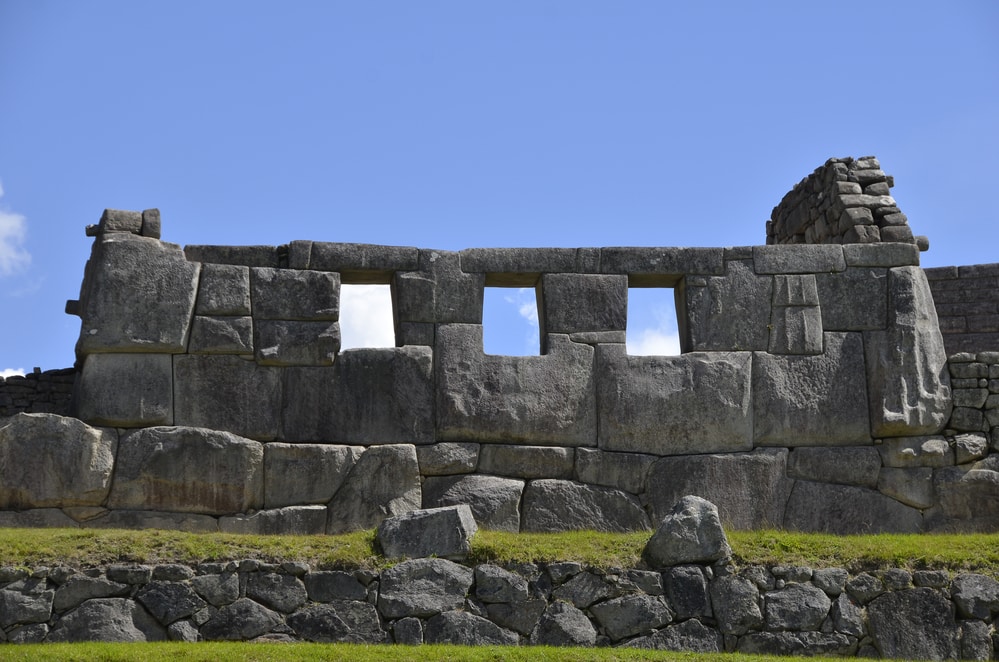
Stone walls of a building in Machu Picchu
The Inca built this city on a hill that receives almost two meters of rainfall every year. So, they created a perfect drainage system that not only drained the water effectively without eroding the soil but also used a part of the water for irrigation.
But it is not clear who built it and when they built it. But historians believe that Pachacuti might have built it in the 15th century as a summer resort house.
4. Religious tolerance
The Inca were highly religious people. Everything they did had a religious meaning behind it.
The Inca prayed to many gods. Among them, their sun god Inti was the most important. They built the Qurikancha temple for him at Cusco, where the first Inca settled. It was the most important temple in the Inca Empire.
The Inca believed in reincarnation. They believed that the body needed to be preserved so that the soul can peacefully pass on to the afterlife. So, they mummified their dead and buried them along with valuable jewelry, textiles, etc. During ceremonies, they took out these mummies and even fed them food as if they were feeding a living person.
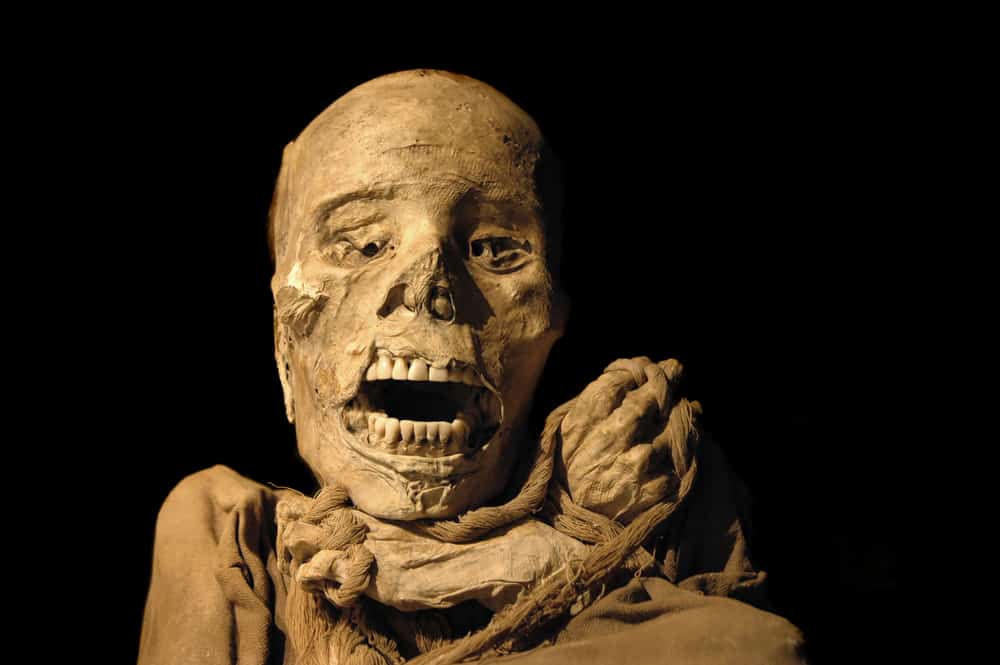
Picture of an Inca mummy
The Inca also sacrificed people and even children, mostly during distressing times like the death of their emperor or severe drought.
But despite having such strict religious beliefs, they also let the conquered tribes follow their own religious beliefs. They even incorporated the gods of the conquered tribes into their religion. In return, the conquered tribes had to respect the Inca gods more than their own gods.
Thus, the Inca practiced religious tolerance to a certain degree. It was a prominent force in bringing people of different ethnicities together and making them feel like part of a big empire.
Thus, by using such methods, the Inca grew rapidly and established the largest empire within a span of hundred years.
The downfall of the Inca Empire
The downfall of the Inca Empire began with the Spanish arrival. When the Spanish invaders landed in Central America, they spread deadly diseases like smallpox and influenza. These diseases spread like wildfire and reached South America too.
As a result, a big portion of the Inca population died, leaving the Inca civilization crippled. As more and more people in the working class died, agricultural output reduced.
Moreover, due to the death of the relay runners who relayed information, Inca’s communication network was severely damaged. So, it became impossible for the ruling class to tell if their territories were attacked.
The Civil war
But the biggest thorn in the flesh came in 1527 when the then Inca ruler Huayna Capac and his eldest son and heir to the throne Ninan Cuyochi died due to smallpox. Due to their deaths, the Inca Empire was left without an emperor.
So, a fight for power began. The two people involved in this power struggle were Huayna Capac’s younger son Huascar and his illegitimate son Atahualpa. Even though Huascar had the right to the throne, Atahualpa was skilled than him in warfare.
Since they couldn’t reach an agreement, the country split into two factions, and a civil war started. After five long years, the civil war ended with the loss of several lives and the victory of Atahualpa.
Spanish Conquest
Thus, in 1532, the Inca Empire finally had a leader. But the empire was completely exhausted due to the diseases and the civil war.
It was at this time that the Spanish invaders led by Francisco Pizarro went to meet Atahualpa. Atahualpa thought it was a peaceful meeting arranged by the newcomers to show their respect to the king.
But the Spanish gave him a copy of the Bible and asked him to swear his allegiance to the Spanish monarchy instead. Atahualpa became angry and threw the Bible away. Taking his action as an excuse, the Spanish killed Atahualpa’s guards.
Atahualpa understood that the Spanish were not there for a peaceful gathering but only for gold and silver. So, he offered to give them a room full of gold and two rooms full of silver if they let him go free. But the Spanish took the money and arrested him.
One year later, the Spanish executed Atahualpa. Then, they attacked Cusco. Even though the Inca had superior numbers, the Spanish had better weapons. So, the Spanish defeated Cusco.
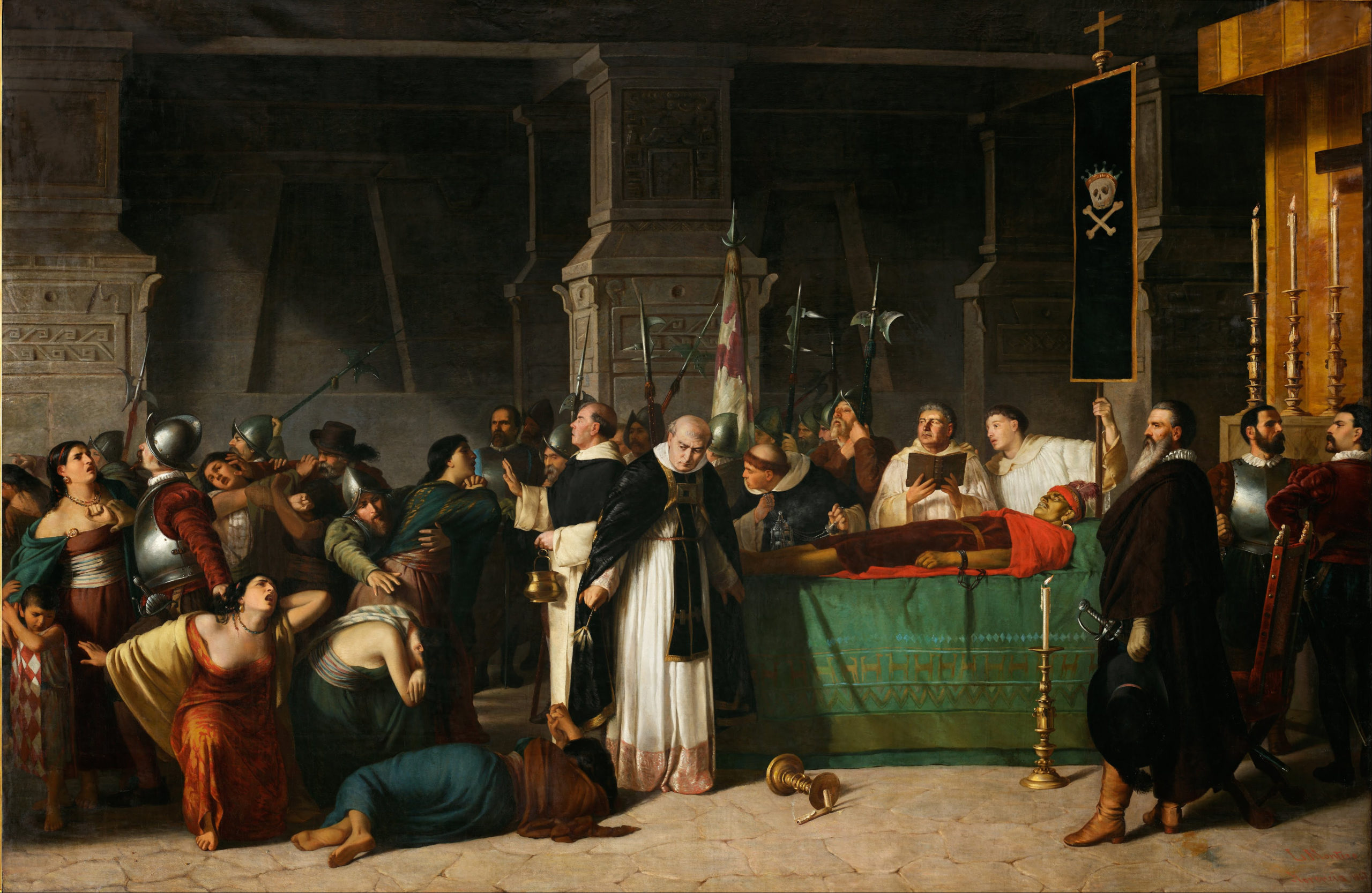
A painting depicting the death of Atahualpa – By Luis Montero (Piura, 1826 – Callao, 1869) – painter (Peruvian)Born in Piura. Dead in Callao.Details of artist on Google Art Project – LgEg2gaAx_wK1w at Google Cultural Institute maximum zoom level, Public Domain, Link
Then, wanting to maintain peace in Cusco, the Spanish installed Manco Inca, Atahualpa’s brother, as a puppet king. But the plan backfired, and Manco Inco was overthrown in 1536. Thereafter, Manco Inca escaped into the mountains. There, he created a government that survived for 36 years. In 1572, the Spanish conquerors captured and executed Manco Inca’s son, thereby bringing an end to his government.
Thus, the mighty Inca Empire came to an end.
Where do the Inca live today?
After the Inca Empire fell, the Europeans started abusing the Inca in all ways imaginable. They enslaved, tortured, raped, and killed the Inca people mercilessly. This resulted in the deaths of thousands, if not millions of the Inca.
But more Inca died due to smallpox and measles, the diseases the Europeans had brought with them. These diseases occurred in three outbreaks during the 16th century in South America. First, a smallpox outbreak occurred, then a measles outbreak, and then both of them occurred together. These diseases affected children as well, thereby affecting the succeeding generations too.
As a result of these diseases and the European colonization, almost 93% of the Inca population had vanished by the end of the 16th century.
Moreover, in the name of converting the masses into Christianity, Europeans also destroyed the Inca religion and culture.
But despite the inhuman treatment leashed out against them, the Inca have not completely vanished. Their culture has also survived.
The Inca traditions and practices are still followed in some countries in South America. Up to ten million people in South America, from Columbia to Chile, speak the Inca language Quechua. The textiles and dishes they make are famous across the world. Their monumental archaeological site Machu Picchu also attracts millions of tourists every year. All these things are reminders of the great civilization that once flourished in these areas.
